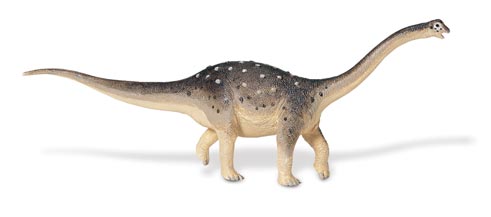Giant Dinosaur Discovered in a Cretaceous “Lost World”
Palaeontologists Reveal new Contender for the “Biggest Dinosaur of All Time”
A new species of huge dinosaur believed to have measured over 105 ft (32 metres) long has been revealed to the world this week. This enormous animal, a long-necked titanosaur was discovered in 2000 by a team of palaeontologists excavating an area rich in Cretaceous fossils on the banks of Lake Barreales in the Argentine province of Neuquén in the badlands of Patagonia.
Huge Dinosaur
The immediate area is rich in plant and animal remains providing scientists with a unique insight into the ecosystem at the time. In the seven years of study, 240 fossil plants have been found, dozens of fish, at least two species of crocodile, hundreds of teeth, a pterosaur and the remains of a predatory megaraptor. The diversity of finds has provided the South American team with a glimpse of their very own “Lost World”. An ecosystem with giant plant-eating titanosaurs, perhaps the largest land animals of all time, wandering the landscape.
This new dinosaur has been named Futalognkosaurus dukei. The genus name has been created from the local Indian dialect Mapuche and means “giant chief of the lizards”. The species name was selected in recognition of the expedition’s sponsors the Duke Energy company of Argentina.
Futalognkosaurus dukei
The very size of this animal’s carcase may have created the conditions needed to trap so much fossil material in one place. Scientists believe that the dead animal’s body blocked a waterway, in effect acting like a giant dam. A logjam of other dead animals and plant materials was then trapped behind it and slowly buried. Marks on the huge fossilised bones show that scavengers fed on the carcase before it was completely submerged. Such a large animal would have attracted a whole host of predators to feed upon it.
The picture shows the size of this animal’s huge bones with a what appears to be a left humerus and vertebrae. The spinal vertebrae weighed 8 tonnes and many of the neck vertebrae were over 1 metre tall. An estimated 70 per cent of the skeleton has been found. It is more usual for only 10 per cent of mega-herbivores to be recovered. This makes it one of the most complete sauropod/titanosaurs ever discovered.
Futalognkosaurus has been estimated at being 32-34 metres long (105-112ft) with the neck alone stretching to over 17 metres. The tail was estimated at 15 metres. These measurements put Futalognkosaurus in the top 5 of big dinosaurs (all of them titanosaurs), with Argentinosaurus (estimated to have been 35 metres long), just keeping the title of the biggest yet described.
The titanosaurids seem to have been particularly successful in South America and remained dominant herbivores in this part of the world right up to the end of the Cretaceous, whilst elsewhere sauropods became less common and were replaced by the ornithopods.
A number of large titanosaurs are known from South America, many of the excavated from this part of Patagonia, Neuquensaurus, Puertasaurus, Antarctosaurus and Titanosaurus.
Some of these titanosaurs developed body armour, perhaps as some protection against the giant megaraptor packs and the huge allosaurs that roamed the plains.
A typical example is Saltasaurus, a small-sized titanosaur tipping the scales at around 8 Tonnes. Several fossilised skeletons have been excavated from Argentina and Uruguay, with thousands of bony plates (scutes) lying around them, these plates, some no bigger than peas provided protection against the giant predators.
A model of a typical titanosaur: Dinosaur and Prehistoric Animal Models.


